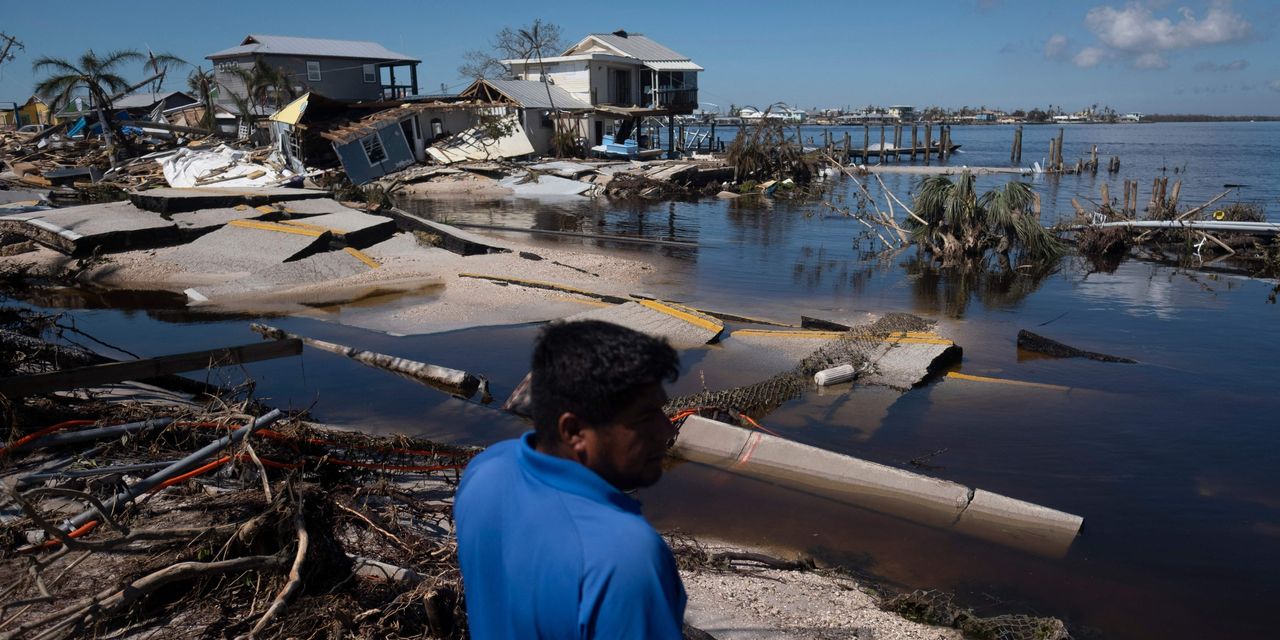Berkshire Hathaway
and other property insurers are making big bets on Florida, predicting that healthy premiums will offset losses in the event of a big hurricane. The big unknown: whether the weather this season will cooperate.
Florida isn’t just an epicenter for hurricanes, it’s also at the forefront of an uncertain market for property insurers. Some are underwriting more policies because premiums started to jump this spring, which would help cushion potential losses. Others have pulled out over fears of another year of severe storms.
The risks and rewards of catastrophe underwriting can be dramatic. Look no further than Berkshire (ticker: BRK.A). Depending on whether a major hurricane hits the Sunshine State this year, the insurance giant said it could either make several billion dollars in profit or lose as much as $15 billion.
Ajit Jain, Berkshire’s vice chairman of insurance operations, told shareholders at the annual meeting in May that the company had underwritten as much property-catastrophe reinsurance as its capacity allowed at the April 1 renewable date. Prices “zoomed up” in the spring and looked attractive to the firm, Jain said. In the first quarter, the segment’s written premiums rose by 30% from last year.
But Berkshire now has a “very unbalanced” portfolio that is particularly exposed to the Florida market, Jain said. If a big hurricane hits this year, the $15 billion potential loss would amount to 5% of the firm’s $300 billion capital. Berkshire didn’t respond to Barron’s request for additional comment.
This doesn’t necessarily mean Berkshire believes the coming hurricane season will be a dud. Although the El Niño weather condition this year tends to dampen the intensity of the Atlantic hurricanes, record heat at the ocean surface—partly caused by increased CO2 emissions from human activities—could mitigate such effects.
Academic and government forecasters aren’t sure which of the competing forces will prevail. Most, including the National Oceanic and Atmospheric Administration, expect the 2023 Atlantic hurricane season to be “near normal.” The NOAA is forecasting a range of 12 to 17 named storms, five to nine of which could become hurricanes, including one to four major hurricanes. Hurricanes along the Atlantic and Gulf coasts in general range from June through November.
“It only takes one event to make a season costly or memorable, as seen during last year’s near-normal season with Hurricane Ian, anticipated to be one of the costliest U.S. hurricanes on record and to reshape insurance markets for years to come,” Moody’s risk modeling experts warned in a June 26 report.
Insurers like Berkshire use weather experts to forecast the probability of natural catastrophes. But whether they write policies in certain regions doesn’t purely depend on that. Other factors, such as how much capital reserve they have and how balanced their entire portfolios look, also play into the decision making.
The amount of premiums they can charge is a key factor. After years of big losses thanks to extreme weather events and inflation, premiums for property-catastrophe insurance have been on the rise since last year. That has given some insurers more reasons to dive in.
Berkshire isn’t alone in accepting possible risks.
RenaissanceRe Holdings
(RNR) CEO Kevin O’Donnell said in a May earnings call that the reinsurance giant expects to increase its absolute dollar exposure to catastrophic events ahead of the hurricane season.
The additional risk would be buffered by the higher premiums the firm charges, he said. Florida, in particular, is starting to see “reasonably good rates” for reinsurers. “Property catastrophe is in a very attractive phase,” said O’Donnell, “That is where we are choosing to deploy our capital.”
The firm recently sealed a deal to buy almost all of
American International Group
‘s (AIG) reinsurance business for nearly $3 billion. “They’re clearly leaning in, and they did it by acquisition,” says Matthew Carletti, an insurance analyst at JMP Securities, a subsidiary of Citizens Financial Group.
RenaissanceRe declined to comment further, citing the quiet period before it reports earnings at the end of July.
Arch Capital Group
(ACGL), a specialty insurer that writes policies to high-risk clients, has been increasing its exposure to property catastrophe as well. The firm has increased its net premiums from property and casualty by 35% over the past year, generating $327 million of underwriting income in the first quarter, CEO Marc Grandisson said on an earnings call in April.
”The reinsurance market in particular is very attractive right now,” he said, “Reinsurance typically reacts more quickly to the changing environment than primary insurance, and we are witnessing this phenomenon in these early stages of improvement in the property market.”
As rates went higher, even some primary insurers have been lured back to the market. Many have gone bankrupt or been hit hard financially after the higher-than-expected losses from Hurricane Ian last year, but those with more solid standing and enough capital reserves are seeing the brighter side.
Assurant
(AIZ) CEO Keith Warner Demmings said in a May earnings call that the firm’s total policies-in-force in Florida has grown by 14,000 last year, although the trend began to reverse in the first quarter this year. “I think that’s a sign of potentially more competitiveness into the marketplace,” said Demmings. To mitigate the risk, the firm said it’s secured more catastrophe reinsurance protection for the year compared with 2022. Assurant declined to comment further.
Not all insurers are willing or able to take on more risk. Some had to shrink their books since they don’t have enough capital—due to years of big losses—to cover the risks. Others might simply want to avoid the volatility. And some want to expand margins on existing policies rather than add more business.
AIG announced earlier this month that it will no longer insure houses along Florida’s coastline, while Farmers Group said it won’t write new policies in the state at all. They have joined the list of at least a dozen property insurance companies that have stopped taking new homeowners in Florida over the past 18 months.
Some insurers have pulled back even more aggressively.
Palomar Holdings
(PLMR) CEO Mac Armstrong said during a June conference call with analysts that the company has reduced its probable maximum loss for U.S. continental hurricanes and severe storms from a peak of $650 million a year to $100 million.
“If you were to apply the same storms in 2020 to 2023, the losses that were $63 million in 2020 would now be less than $5 million,” he said, noting that the segment now makes up just 5% of the firm’s total probable maximum loss.
Palomar didn’t respond to Barron’s request for additional comment. AIG declined to comment.
Wall Street analysts have warned that primary insurers, which would shoulder catastrophe damages before reinsurance kicks in, might be in a more precarious position this year. As reinsurance costs surged, some insurers had to cut their reinsurance coverage and take on more risk themselves.
This means if a major hurricane hits in 2023, many primary insurers will face larger financial hits than previous years. This could lead to insolvency of smaller firms with weak balance sheets, which often don’t have access to additional capital since they aren’t publicly traded, says Meyer Shields, managing director at investment bank KBW.
Reinsurers, on the other hand, would see much less damage since the threshold for them to take over the payment responsibility has increased significantly. “Changes in reinsurance are very favorable,” Shields said. “It’s not free of risk but it’s a much better trade off than it has been in a while.”
Reinsurers actively expanding into property catastrophe, such as RenaissanceRe and Arch Capital, are particularly attractive, says JMP’s Carletti: “That’s what you’d expect from good underwriters—when you’re getting paid a lot more money to take on the risk, you don’t run away from it.”
Write to Evie Liu at [email protected]
Read the full article here













